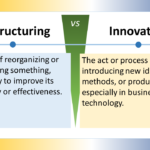The difference between restructuring and innovation lies in the intent and approach towards change within an organization or system.
Restructuring is a strategic move to alter the internal setup of an organization—such as its processes, operations, or structure—to improve efficiency or adapt to new circumstances.
Innovation involves the creation or significant improvement of products, services, processes, or ideas, aiming to generate new value or growth.

Definition
Restructuring
Restructuring is the corporate process of reorganizing the legal, ownership, operational, or other structures of a company to make it more profitable, better organized, or more aligned with current needs.
- Characteristics of Restructuring:
- Organizational Change: Typically involves changes in management, strategy, or operations.
- Cost Reduction: Often aims to reduce expenses and streamline processes.
- Survival Strategy: Can be a response to financial pressures, market changes, or a desire for increased competitiveness.
Innovation
Innovation is the introduction of new ideas, products, services, or processes that add value or solve problems in unique or more efficient ways.
- Characteristics of Innovation:
More Synonyms on innovation, innovate and innovative
Innovation Terms

Innovation is considered as a driving force in progress.
It includes the introduction of novel ideas, methods, or products that bring positive change and advancement.
For more information about innovations, check our glossary
Relationship and Relevance
Restructuring can sometimes be a precursor to or a consequence of innovation. For instance, a company may need to restructure to foster a culture that supports innovative thinking, or it may need to restructure its operations to implement and scale a new innovative product or service. While restructuring is about optimizing the existing setup, innovation is about breaking new ground.
The key difference between restructuring and innovation is:
Restructuring refers to making significant changes to the organizational structure, processes, or business model of a company or entity. It involves rethinking and redefining the core elements of how the organization operates.
Restructuring can include changes like mergers, acquisitions, downsizing, or reorganizing departments and reporting structures. The goal is to improve efficiency, competitiveness, or adapt to changing market conditions.
Innovation, on the other hand, is the introduction of something entirely new - a novel concept, product, service, or way of doing things that did not exist before. It goes beyond just changing the existing and creates something fundamentally different.
Innovations, such as the creation of the smartphone or the ridesharing model pioneered by Uber, disrupt existing industries and change the status quo in a significant way. They are not just incremental improvements, but transformative breakthroughs.
In summary, restructuring focuses on reorganizing and redefining the core structure and operations of an organization, while innovation involves creating something new that did not exist previously. Restructuring is about optimizing the current state, while innovation is about introducing something completely novel.
Context for Using Each Term
- Restructuring is a term often used in the business and corporate world, particularly when companies face financial difficulties, undergo mergers or acquisitions, or need to adapt to a changing industry landscape.
- Innovation is used broadly across various domains, including technology, business, and academia, to describe the act of introducing novel ideas and translating them into valuable products or services.
Example of Utilization
A multinational corporation that reorganizes its departmental structure to reduce redundancy and improve communication is undergoing restructuring. A tech company that develops a new artificial intelligence algorithm that can predict consumer behavior is engaging in innovation.
In summation, restructuring is focused on changing the internal configuration of an organization for better performance or adaptation, while innovation is concerned with creating new value through fresh ideas and advancements.
- Model
- Restructure or Reconfigure?
- Transformation vs. Restructuring
- What Is the Difference Between Corporate Restructuring & Business Restructuring?
- Innovation vs. Reform
FAQ
Q1: Can restructuring and innovation occur simultaneously?
A1: Yes, organizations can pursue both strategies concurrently, often with restructuring supporting innovative initiatives.
Q2: Is restructuring always about cost-cutting?
A2: While cost reduction is often a goal, restructuring can also focus on improving efficiency, agility, or alignment with strategic objectives.
Q3: Does innovation always require significant investment?
A3: Not necessarily. While some innovations require substantial resources, others can be achieved through creative thinking and process improvements.
Q4: Which is more disruptive to an organization: restructuring or innovation?
A4: Both can be disruptive, but restructuring often has a more immediate impact on employees and daily operations.
Q5: How do companies decide between restructuring and innovation?
A5: The decision depends on various factors, including the company's financial health, market position, competitive landscape, and long-term strategic goals.

